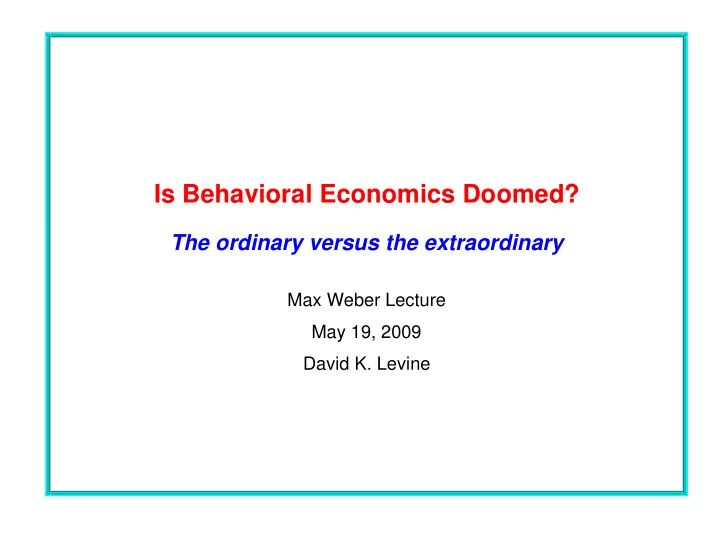

Is Behavioral Economics Doomed? The ordinary versus the extraordinary Max Weber Lecture May 19, 2009 David K. Levine
Rational Economic Man “a lightning calculator of pleasures and pains, who oscillates like a homogenous globule of desire of happiness under the impulse of stimuli” Thorstein Veblen 1899 “The implicit presumption in these … models was that people could be fooled over and over again." Robert Lucas 1995 1
Theory That Works: Voting Levine and Palfrey [2007] 2
Theory That Works? Ultimatum Bargaining Roth, Prasnikar, Okuno-Fujiwara, Zamir [1991] 3
What the Theory Tells us: Losses In Ultimatum Out of $10 Losses Knowing $0.34 Unknowing $0.99 Fudenberg and Levine [1997] � Learning and short-term errors are an important part of mainstream economics 4
Equilibrium: The Weak versus the Strong Approximate or � -equilibrium � strategy choice; � beliefs; � � utility � � � � � � � � � � � � � � � � � � � � � � equilibrium: beliefs are correct 5
Individual Play in Voting 6
Quantal Response Equilibria � mixed strategy or probability of play � parameter � � � � � � � ���� � � �� � � � � � � � � � � � � � � � � � �� � �� � � � � � � � � � � � � � � � � Games with Strong Equilibria � voting � competitive equilibrium 7
Learning and Self-confirming Equilibrium government chooses high or low inflation…then in the next stage consumers choose high or low unemployment; but prefers low unemployment government gets 2 for low unemployment plus 1 for low inflation subgame-perfect equilibrium: government chooses low inflation and gets 3 self-confirming equilibrium: government believes that low inflation leads to high unemployment, so chooses high inflation and gets 2 no data is generated about the consequences of low inflation Sargent, Williams, Zhao 2006: detailed explanation of how learning by the U.S. Federal Reserve led to the conquest of American inflation 8
The Ordinary, the Extraordinary and the Dishonest Periodic short crises during which long-run beliefs of consumers are wrong, although short-run beliefs are right Sargent, Williams, Zha 2008 � The current crisis: the ordinary; the extraordinary and the dishonest 9
Procrastinating at the Health Club � people who choose membership pay more than $17, even though a $10-per-visit fee is also available � agents overestimate … delay contract cancellation whenever renewal is automatic ($70 per month) DellaVigna, Malmendier 200 Hypothesis 1: people think incorrectly that they will cancel tomorrow Hypothesis 2: people think it will be an expensive hassle to cancel; wait for “hassle” cost to be low Takes 2.3 months to cancel after stopping attendance � Eliot Spitzer, Rush Limbaugh and the Las Vegas vacation 10
Prospect Theory to the Rescue Suppose that � � is the chance of winning one of two prizes � � � � ���� ���� � � ����� � � � � � ���� ���� � ���� �� � � � � � � � Bruhin, Fehr-Duda, and Epper [2007] Would you rather have: A. $5,000 for sure B. a 50-50 coin-flip between $9,700 dollars and nothing ***and*** you don’t exhibit the Allais paradox 11
Framing and the Becker Marschak DeGroot Elictation Procedure � Willingness to pay versus willingness to accept Zeiler and Plott 2004 12
Psychology versus Economics � non-functional versus functional people � narrow models versus broad models � individual versus group behavior � arithmetic versus axiomatic models and the domain of concern � pieces of paper, computers and neuroeconomics 13
Strengthening Economic Theory Mainstream models � learning � habit formation � consumer lock-in Works in progress � ambiguity aversion and the dishonest � level-k thinking and one-off play � menu choice and self-control � interpersonal preference 14
The Rabin Paradox If you are indifferent between a 70% - 30% chance of A: $40 and $32 B: $77 and $2 And your lifetime wealth is $860,000 then your coefficient of relative risk aversion is 27,950 If you are indifferent between holding stocks and bonds your coefficient of relative risk aversion is 8.84 � The reference point is real 15
Recommend
More recommend